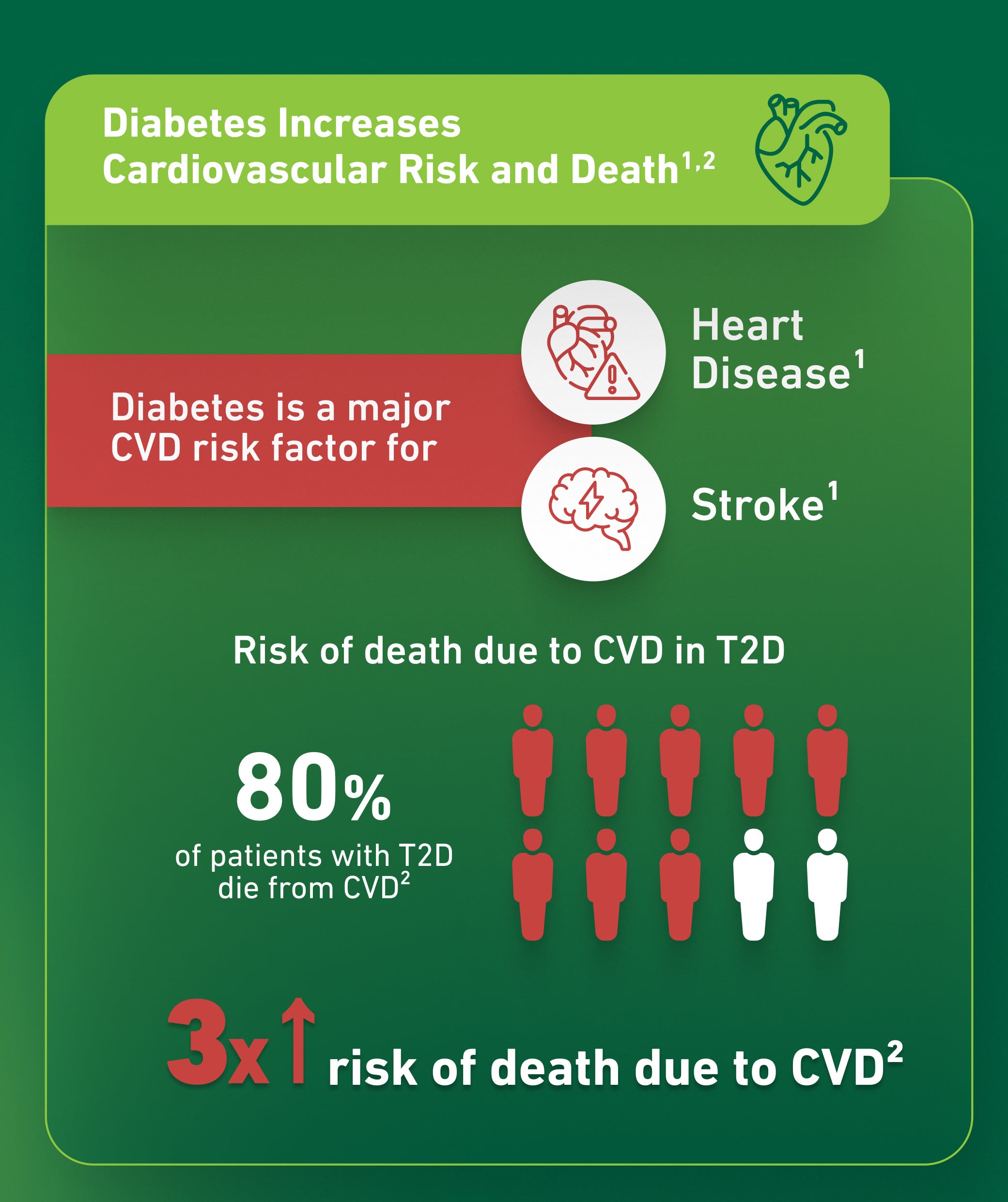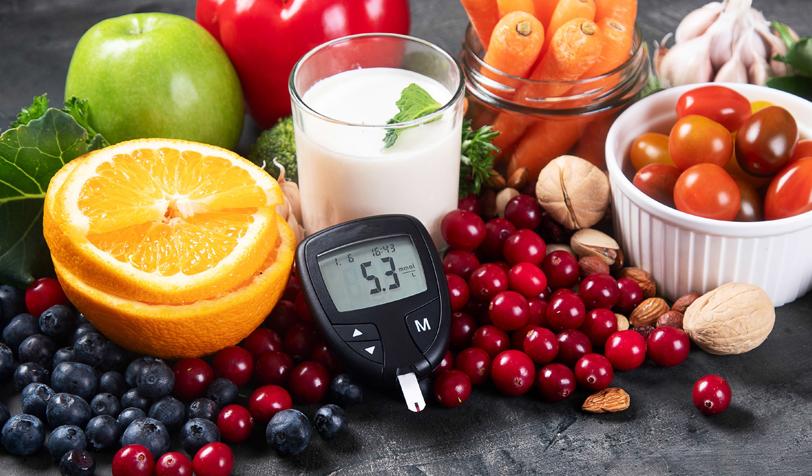Heart Health in Type 2 Diabetes
Type 2 diabetes (T2D) patients have a higher risk of cardiovascular disease (CVD), which includes heart disease and stroke. As shown in figure 1, studies estimate that 80% of patients with T2D die of CVD.1,2 Postprandial hyperglycemia (PPH) which is the earliest symptom of diabetes, is a major cause of long-term complications such as heart disease and stroke.3 Moreover, dyslipidemia, which is marked by hypertriglyceridemia, high low-density lipoprotein (LDL) cholesterol, and low high-density lipoprotein (HDL) cholesterol, is a major cause of atherosclerosis and CVD. Patients suffering from T2D are predisposed to dyslipidemia, which in return makes them highly vulnerable to heart attack, stroke, and other cardiovascular comorbidities.4

Heart Healthy and Diabetes Diet
Whey protein is a scientifically backed food for diabetes and cholesterol sufferers. Whey has been extensively researched for improving glycemia in T2D. Now, new evidence indicates it can contribute toward heart health, in particular, managing dyslipidemia, a major underlying cause of CVD. This article sheds light on a systematic review and meta-analysis of 22 controlled clinical trials with over 1,100 participants, documenting whey protein's efficacy in correcting dyslipidemia and reducing CVD risk.4
Evidence-Based Food for Diabetes and Dyslipidemia
Figure 2 illustrates evidence-based benefits of whey protein on heart health. Meta-analysis of 22 trials demonstrated that whey protein reduced blood lipid levels. Whey protein led to a reduction of cholesterol/HDL ratio, total cholesterol, LDL, and triglycerides in metabolic syndrome patients, which in turn reduced CVD risk.4,5

Whey Protein and Lipid Profile: Systematic Review and Meta-Analysis
Amirani et al. study about “Effects of whey protein on glycemic control and serum lipoproteins in patients with metabolic syndrome and related conditions” reviewed 22 RCTs involving over 1,100 participants.4 The study results confirmed the following whey protein benefits for blood lipid profile:
Amirani et al. Study Key Findings:
- A reduction in TG levels by a weighted mean difference (WMD) of -17.1 mg/dL (95% CI: −26.5, −7.7).6-8
- A reduction in total cholesterol levels was observed, with a WMD of -10.9 mg/dL (95% CI: −18.6, −3.2).7-10
- A reduction in LDL-C, often referred to as "bad cholesterol," by -8.5 mg/dL (95% CI: −16.6, −0.4).7,9
- A reduction in the TC/HDL ratio by -0.26 (95% CI: −0.41, −0.10).9-11
Whey Protein Mechanism of Action
Whey protein mechanism of action is illustrated in figure 3. Whey protein suppresses cholesterol absorption and liver lipid generation. The branched chain amino acids (BCAAs) in whey protein can reduce levels of triglyceride and improve lipid metabolism. All these actions combined play a role in a healthier lipid profile.12-17

Additional mechanisms of action of whey protein:
Whey protein also indirectly improves lipid metabolism and cardiovascular health. It improves insulin sensitivity, releases GLP-1 and inhibits ghrelin, and is anti-inflammatory in action, all of which lower CVD risk. Whey notably contains cysteine that produces glutathione, a strong antioxidant that can combat oxidative stress in dyslipidemia and endothelial dysfunction.4
Using Whey Protein in Practice
Evidence is in favor of inclusion of whey protein in T2D patient diets for managing risk of CVD. In individuals who have a high risk of obesity or who suffer from prediabetes, whey protein may be included in a prevention program.4
References:
- Institute for Public Health. National Health and Morbidity Survey (NHMS) 2023: Non-communicable Diseases and Healthcare Demand — Key Findings. 2024.
- Sowers JR, et al. Hypertension. 2001;37(5):1053–9.
- Mignone LE, et al. World J Diabetes. 2015;6(14):1274–84.
- Amirani E, et al. Lipids Health Dis. 2020;19:209.
- Wang N, et al. Circ Cardiovasc Qual Outcomes. 2022;15(6):e008552.
- Mohammadi-Sartang M, et al. Nutr Metab Cardiovasc Dis. 2018;28(6):565–74.
- Tovar J, et al. Nutr Metab (Lond). 2012;9:29.
- Fekete AA, et al. Am J Clin Nutr. 2016;104(6):1534–44.
- Tovar J, et al. Eur J Nutr. 2016;55(6):2295–303.
- Denysschen CA, et al. J Int Soc Sports Nutr. 2009;6:8.
- Kemmler W, et al. BMC Geriatr. 2018;18:70.
- Pal S, et al. Obesity (Silver Spring). 2010;18(7):1354–9.
- Graf S, et al. Curr Opin Clin Nutr Metab Care. 2011;14(6):569–80.
- Ohlsson L, et al. Am J Clin Nutr. 2010;91(3):672–8.
- Sawyer L, et al. Biochim Biophys Acta. 2000;1482(1–2):136–48.
- Reimer RA, et al. Nutrition. 2009;25(3):340–9.
- Mortensen LS, et al. Eur J Clin Nutr. 2012;66(7):799–805.
Whey protein is well-known for its role as a non-pharmacological supplement for managing blood sugar levels, but did you know about its role in a heart healthy diabetes diet? This article sheds light on findings from 22 randomized controlled trials (RCTs) involving over 1,100 participants, highlighting how whey protein can benefit the overall lipid profile and heart health.
